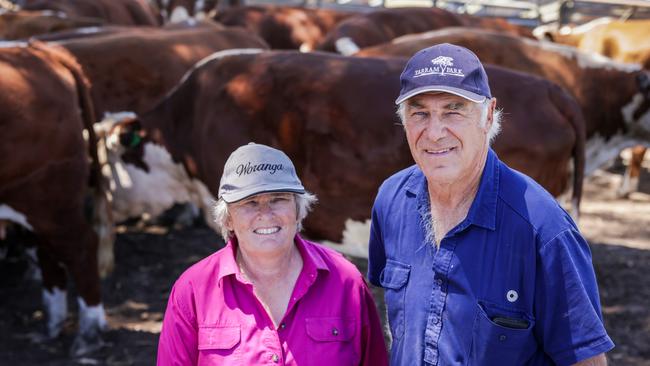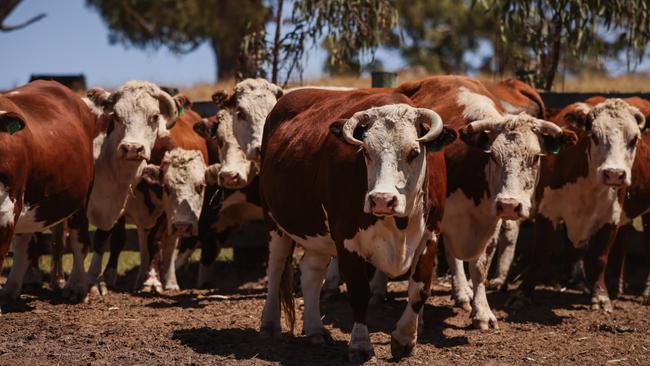Hortle family breeds balance with bloodlines
Switching to three-year-old heifer calving has been a game changer for the Hortle family at Casterton. Here’s why.
The logistics of farming across seven properties that are within 15km of each other, but only two of which actually neighbour, has Jeoff and Jill Hortle contemplating drones to help inspect cattle and cut down on travel time and expense.
It also has them thankful for management decisions that have helped increase efficiencies over the years and enabled them to still produce cattle that consistently perform among the best pens of weaners at the annual calf sales.

The Hortles run 300 breeders on their Casterton properties and have stayed true to the Hereford breed for ease of management and handling, docility, longevity and doing ability.
But the biggest impact on herd management was the introduction of three-year-old calving 30 years ago, which works “exceptionally well”.
“From a management point of view, the three-year-old calving has really reduced the workload and the overall health of the herd has improved because we don’t have lighter heifers being bossed around by older cows,” Jeoff said.
“We don’t necessarily calve heifers where we can keep an eye on them. It has made my life a hell of a lot easier not having to worry about the two-year-old heifers calving.
“You lose a paddock, and you don’t have quite as many calves to sell but it works well for what we do. They get in calf a lot easier the next time round and the cows last because they haven’t had a hard trot.
“When they are rising two-year-old and have a calf inside they don’t grow, whereas if you let them grow out that extra year without a calf they grow out better and I keep them for 10 to 11 years.”
STRIKE IT RIGHT
The Hortle herd was originally based on South Boorook and Bowmont Herefords but for the last 10 years Yarram Park bloodlines have been used with Jeoff and Jill paying up to $19,000 for bulls.
“Our herd is to a point now we can afford to buy reasonably priced bulls,” Jeoff said.
“You’ve got to buy quality. Bulls can cause a lot of problems in your herd if you strike the wrong one.”
Jeoff aims to spend up to the current value of five or six steers on each bull.
“This year our steers averaged $1500 so we’d spend around $10,000 for a bull, but I reckon they will be a bit dearer than that,” he said.
“I was down about $500 a head this year on the steers and $460 a head on the heifers. I don’t think we’ll get that sort of reduction in bull prices for the good bulls. Some of the cheaper bulls might be cheap but the top half of the bull catalogues will still be well up there with what we paid last year.”

LOOK AND SEE
The Hortles buy two to four bulls a year for natural joining in their autumn-calving herd.
“I would try artificial insemination if my properties were closer together but the logistics of organising it is difficult,” Jeoff said.
When seeking bulls, Jeoff said figures were important but visual assessments were a priority.
“I don’t like the bulls with big shoulders and a really thick neck. That seems to lead to calving problems with any cow that is a bit smaller than normal,” he said.
“I go a fair bit on birthweight, they’ve got to have a brown pigment around both eyes, I am pretty particular about the feet side of it – they have to have straight toes, and they’ve got to have four decent socks, preferably with no brown collar around their neck.
“He’s also got to be a reasonable size and shape and they have to be quiet. It’s one reason we’ve stuck with Yarram Park bulls – the docility of them. It flows on through all your stock. If I can’t get in a cattle yard or a forcing yard to the truck with a bull, then I don’t want him.”
GREENER PASTURES
Seasonal conditions have been favourable again this year for the Hortles, whose properties border much of the Glenelg River.
“It’s the first time I can remember we’ve had green grass at the end of January,” Jeoff said.
“I did over 1200 bales of hay this year when usually I do about 800 to 900 rolls. We had rain at the right time to keep it growing. It is some of the best hay I’ve ever cut.”
Calves were heavier at the point of sale this year than last year with weights topping at 345kg for steers and 298kg for heifers at 8.5 to 10 months old.
Jeoff said while prices were back on last year, it was within reason.
“We’ve got to be a bit practical about things. It’s alright to get these massive prices but the bloke buying them has to make a dollar or he won’t buy them next year,” he said.




